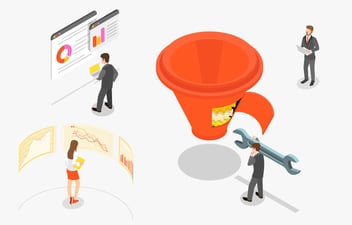If you work in the recruitment industry, we can bet you know how important first impressions are. A good candidate will look smart, have a polished CV and will be ready to answer any questions in an interview.
And what about you, as the recruiter? If you meet said candidate, you’ll want them to trust you and your ability to place them in a good role. You’ll speak confidently, assuring the candidate that you have plenty of opportunities for them.
You’re representing your agency, so it’s vital that you make a good impression. Is that where it ends, then? What about your online presence?
In such a competitive industry, recruitment agencies can often overlook the benefits of a website designed for lead generation and business growth. It can make the difference between winning or losing that lucrative contract.
So, with this in mind, we have created this comprehensive guide for recruitment website design. Without further ado, here are the keys to recruitment success...
1. You Can’t Go Anywhere Without A Roadmap

When your prospective candidates first encounter your agency’s site, you want to give them a clear idea of how the site works and where they should click next. Clean, useful website mapping will boost SEO and improve user experience by quite a margin. Given the fact Google prioritises content with good, transparent structure, road-mapping needs to be a top priority.
It helps to think like a user. How would you approach a website? Where should you go next? Put yourself in the shoes of your visitors, and design accordingly.
Designers often refer to ‘wire-framing’ - this is the act of mocking up a skeleton ‘wireframe’ website which people can test out and it has proven helpful for tons of marketers. With this, you are able to spot potential weaknesses before the site is live for consumers to see.
You wouldn’t set off on a journey without, first, knowing where you wanted to go. Don’t let clients and candidates land on your site without knowing where you want to direct them.
2. Communicate Earlier, Rather Than Later

What would you say is the most crucial information that your agency needs to communicate to visitors? A statement that sums up what your business is all about and why clients and candidates should engage with you.
We call this your positioning statement and needs to be up there front and centre as the first thing visitors see when they land on your site. We recommend putting this on your homepage, above the fold so that visitors instantly understand your offering.
In the recruitment industry, this is vital.
For example: if your agency specialises in financial recruitment, someone coming onto your site will know to look elsewhere if they don’t work in finance. It sounds a little like we’re stating the obvious, but it happens more than you may think.
So, are you now wondering how to create the perfect positioning statement for your website?
I thought so. Here are 3 simple steps to help you achieve this:
- Choose the category that your brand operates in. Focusing on your chosen category can define a clear direction for your recruitment website.
- Can you provide your customers with a unique selling point (USP)? What value can you provide that no one else can?
- Why should they believe you? Can you backup your information with facts?
The final step is to proofread. Proofreading can shed any light on any potential weaknesses, so this is a crucial final step to take to ensure a successful positioning statement. You don’t want it to be misread and proofreading can iron out any potential misunderstandings.
3. Make User Navigation As Easy As Possible

Your candidates are on the hunt for a new job and are possibly looking for something immediately. Make it easy for them with smooth site navigation.
Be transparent, and ensure there is no possibility of being misunderstood. Is there clear instruction as to what the user needs to do next? Are your CTAs positioned in the right place, and are they noticeable? Can the user move around the site easily? These are all things you should think about.
If you are starting from scratch or just tweaking your website design, look no further as we have some great tips to ensure you achieve better results! Here they are…
- Connecting the businesses priorities with the navigation of the website. The is key to directing customers to fundamental pages which can have the most impact on them. Making use of these pages will help the customer explore and find the relevant information for them. Adding pages like “About” or “Contact” will help with general curiosity. Once you have done this, make sure you add a CTA, such as “Download the mobile app.”
- Make sure hypertext is obvious. This is a common problem among some websites and can get in the way of a user’s usability. If it isn’t clear what users should be clicking on your site, you risk losing them too easily.
- Be aware of your navigation bar. No one likes clutter. Use main headers if your website is looking cluttered which will help with organisation and overall layout. A website that looks clean and well organised is more appealing and will keep them on-site for longer.
These tips will help you on your way to achieving customer satisfaction. If your customers can make their way around your website with ease, this will make their lives a lot easier!
Are you using WordPress to design your website? Stop what you're doing and read this blog: HubSpot CMS Review: 9 Reasons It Beats Wordpress. Discover the benefits of using HubSpot's CMS.
4. Ensure Full Security For Your Website

This is vital if your candidates are posting CVs and other documents onto your site. With their personal information on your database, it’s the agency’s responsibility and duty of care to safeguard that information.
One of the most effective and noticeable methods is to configure your website to use HTTPS rather than HTTP. This ensures that the connection between the visitor and your site is encrypted and, combined with a valid certificate, proves that you are who you say you are. Further steps you can take involve ensuring the server that hosts the website is kept up to date and is properly configured.
Additionally, taking great care of how the data is stored and accessed (e.g. Sanitised Inputs) all contribute to a secure and trustworthy website.
There are a number of ways you can improve security on your agency’s site. Your best option is to implement some HTTPS methods. What HTTPS will do is guarantee to users that they are in straight, direct communication with the right server and that nobody can intercept or interfere with that connection.
5. Have Your Contact Information Visible

Having your contact details visible is one of the most important aspects of website design for recruiters.
As a recruiter, you need to be an open book. Your candidates need to know how to get in touch, so make sure the contact information is clear to see and isn’t hidden away anywhere. For a candidate in the midst of a job search, it can be very frustrating if contact details are nowhere to be found.
You can have your email, phone number, address and Google Map directions all in one place - easy to access for candidates everywhere. Another option would be to set up a form, which users can enter their details into to get in touch.
This form is a way to stay connected with your customers so that you can offer them your exclusive help. Looking for a new job can be a tricky process and an email offering your help could provide a personal touch that they might not get elsewhere.
6. Have An FAQ Section

You’re a recruiter. You want to open a dialogue between you and your audience, right? That’s largely what your content is for. What an FAQ section does is strengthen that channel of communication by offering help to anyone viewing your agency’s website.
With a clear FAQ section, you can receive feedback from customers to continue improving your site with a positive, encouraging channel for communication.
An FAQ section is a major factor that customers use to see if you can actually solve their problems, so this section should answer a variety of questions that customers might ask about the recruiting process.
Note that a good FAQ section won’t bombard visitors with too many questions, consolidating all topics in as few questions as possible. Your agency should also make sure it’s easy to find and you can tailor the questions to which page the visitor is on so they get relevant answers to what they might want to ask.
7. Get Involved With Social Media

Social media has a lot to answer for, in terms of job seeking.
These days, candidates can find countless jobs on their Twitter feed, and can also use LinkedIn to build networks and create opportunities for themselves.
By researching relevant hashtags and reaching out to candidates, you speak to them on their own platform, in a sense. You, as the recruiter, talk to the candidate on their own terms, in their comfort zone.
It’s a fresh channel for recruiters to pursue and it’s worked incredibly well so far. By integrating your website with social media, you’ll double up on your communication pathways to further open dialogue between you and your candidates.
Social media will also help your agency’s SEO status and will strengthen your digital footprint in the industry. You can comment on industry developments, be a leading voice and keep your audience engaged.
We live our lives on social media these days and you need to adapt your recruiting practices to capture attention on these platforms. If you aren’t making use of social media platforms such as LinkedIn, you’re seriously falling behind the eight ball.
Your website should be no different. You need to keep up with this social trend and incorporate social media into your site’s design at every stage. Your site is an opportunity for visitors to engage with you on the platforms where they spend most of their time. Make sure all your social icons are clearly displayed and you’re incorporating your social activities into the design of the site.
8. Be Mobile-Friendly!

71% of marketers believe that mobile marketing is core to their business - the remaining 29% will be left way behind.
So widespread is mobile use that over 50% of smartphone users pick up their mobile upon waking - we’re exposed to so much content through mobile that it’s where we are most comfortable.
The possibilities are endless for mobile marketing, where you can tailor content for a number of different devices. Like with social media, we spend our lives on our phones these days. Why wouldn’t you want to optimise your website for this market?
Make sure every element of your site is scalable and functional on mobile and tablet devices. Your website might look great on a desktop but if the vast majority of visits come from mobile users, and your site isn’t adaptable to them, you’ll start to see your engagement drift to those rival recruiters who are capturing the attention of mobile users.
9. Reliable Hosting

Go for a well-known, trusted and, for lack of a better word, ‘mainstream’ internet provider. It may cost a few more pounds each month but, in the long-run, you’ll benefit from consistent, speedy hosting.
With 40% of users abandoning a site that takes longer than three seconds to load, ensure that your website’s speed is quick and running as smoothly as possible. Candidates and clients have short attention spans these days and, if you aren’t up to speed (so to speak), you risk losing them.
Shoddy web hosting can also have negative effects on SEO, meaning that you should make this a priority. If 40% of your visitors are leaving immediately because your site is taking too long to load, search engines will read that as them leaving because your site isn’t valuable or isn’t relevant. This will impact negatively on your SEO and overall search engine rankings, making you harder to find.
10. Meet The Team

You need to make a section of your agency’s site dedicated to your team. Why wouldn’t you want to promote all your brilliant recruiters?
While this may seem like an added extra or maybe a luxury, given the nature of recruitment, you want your candidates to feel comfortable with you and those working at the agency. Like we mentioned earlier, you need to present yourself as an open book. Presenting your team and their contact information clearly on your site makes clients and candidates more likely to get in touch.
It adds a personal touch and instills trust in both your candidates and the agency as a whole. You are people, after all, so show it! Candidates will appreciate the personal touch, and will likely remember a particular recruiter if they’d already seen their profile on your site.
If you want to boast the best recruitment agency website around, these tips will help you on your way. Remember, recruitment is very much a people-centric industry. You need great communication skills, an aptitude for research and a keen eye for detail - your website is an extension of all of that!
With the principles of Growth-Driven Design (GDD), you can make this a reality. GDD relies on a cycle of improvement for your site, working on it in stages to ensure you have a prime sales asset live as soon as possible. This kind of web design works efficiently for a fast-paced industry like recruitment.
If you’d like to speak more with Digital Media Stream, please get in touch with a member of our team today and learn about how we can transform your website into a lead-generating machine.




